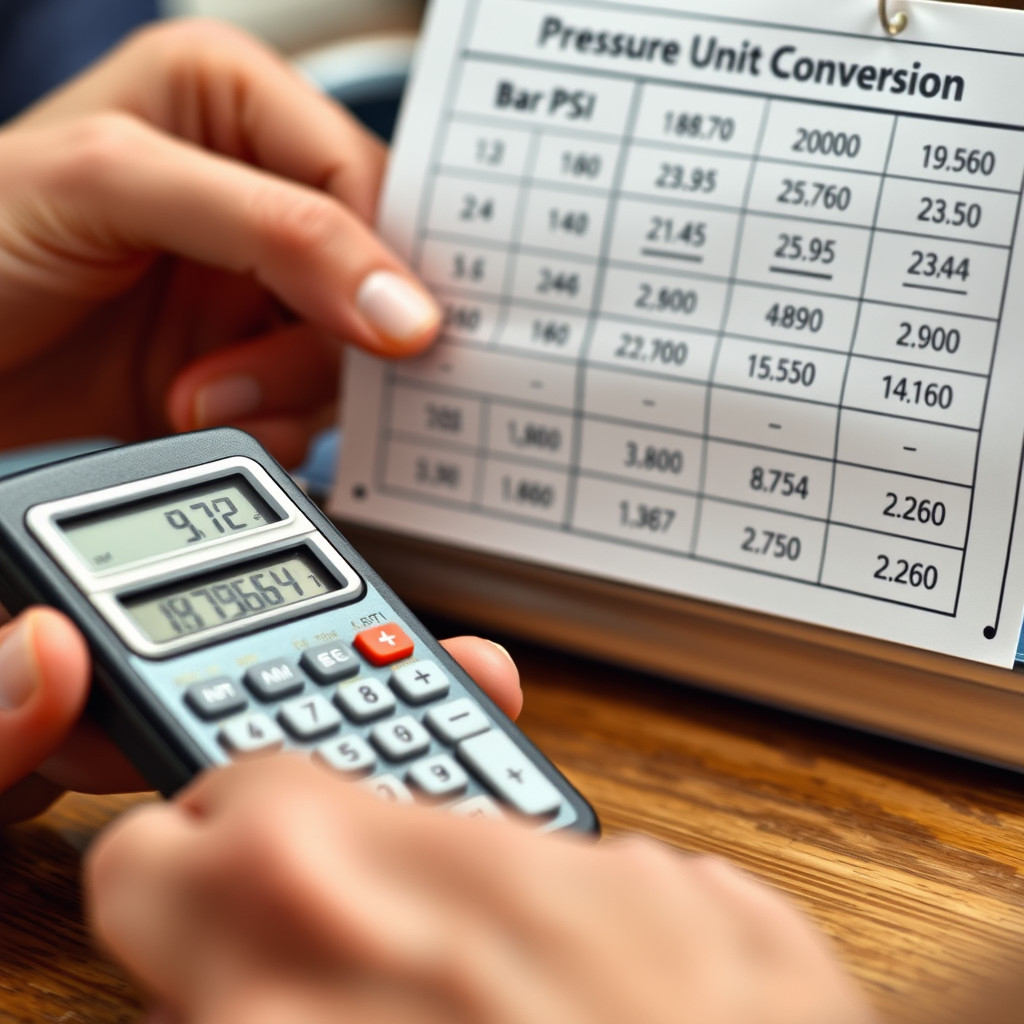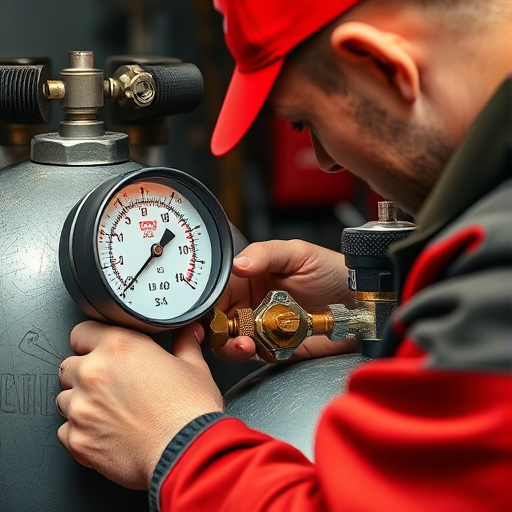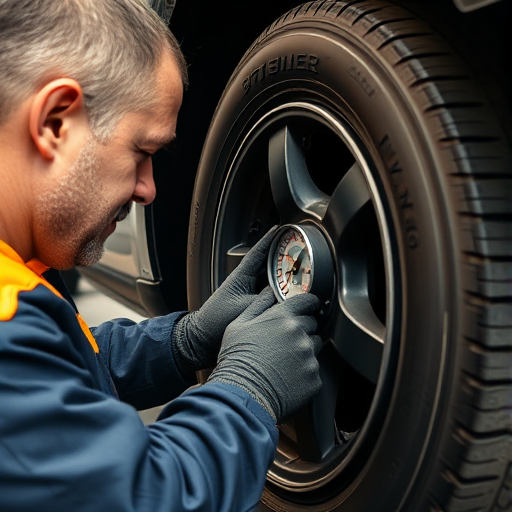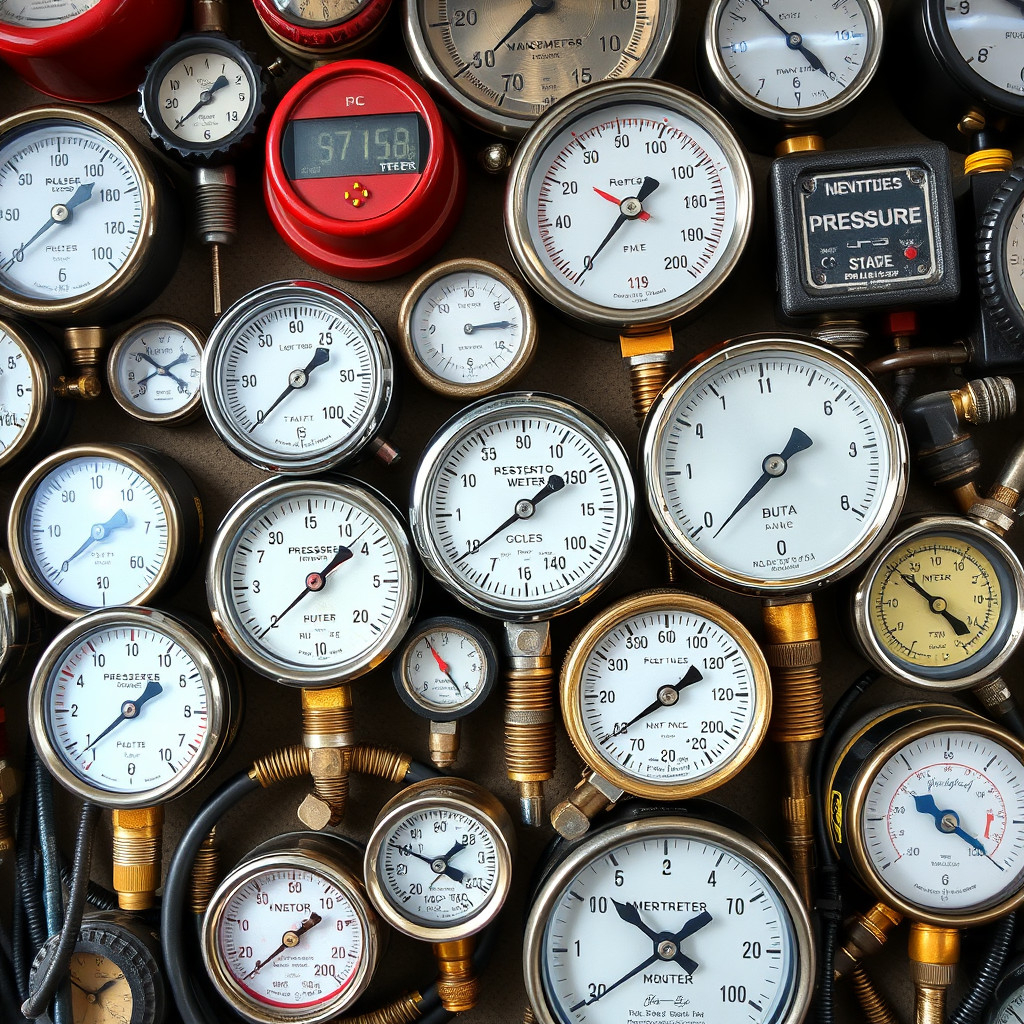Pressure Guide - PSI and Bar Basics
Learn how to convert PSI and Bar pressures with this easy guide.
Pressure units like PSI and Bar can be confusing, but we're here to make it easy. Let's learn about pressure units and how to convert between PSI and Bar!

Understanding Pressure: The Basics
Pressure is the force applied over an area. Think of pressing your thumb on a table. The force from your thumb over the area it touches creates pressure on the table. Pressure is everywhere—in the air we breathe and in the water moving through pipes.
Scientists measure pressure in units called Pascals (Pa). One Pascal equals one newton of force over one square meter. But in everyday life, Pascals can give us big numbers or fractions, which isn't practical.
That's why we use units like PSI and Bar. They give us numbers that are easier to handle day to day. Knowing these units helps us stay safe and make sure things work right. Whether pumping up a bike tire or checking a fire extinguisher, understanding pressure units helps us use equipment safely.
A Brief History of Pressure Units
Let's see where these units come from. PSI stands for Pounds per Square Inch and comes from the imperial system used in England long ago. Bar comes from the metric system, which began during the French Revolution to standardize measurements. The word "Bar" comes from the Greek word "baros," which means weight.
What Is PSI and How Is It Used?
PSI means Pounds per Square Inch. It's a pressure unit mainly used in the United States and other places that use the imperial system. One PSI is one pound of force on one square inch area.
We use PSI in many daily situations. For instance, when inflating car tires, the pressure is often in PSI. A car tire might need 32 PSI to work best. We also use PSI to check water pressure at home or in a garden hose. PSI is used in aviation, hydraulics, and even in weather forecasting for atmospheric pressure.
In industry, using PSI helps keep machines running safely. Too much pressure can cause equipment to fail or be dangerous. Technicians use accurate PSI readings to watch and manage systems properly.

Exploring the Bar Unit of Pressure
Bar is a metric unit of pressure, used widely in Europe and other countries that use the metric system. One Bar is 100,000 Pascals, about the same as atmospheric pressure at sea level, which makes it handy for many uses.
Bar is often used in meteorology, scuba diving, and even making espresso! For example, an espresso machine works at about 9 Bar to make a perfect shot. In weather forecasting, pressure maps may show readings in millibars (mb), where 1 Bar equals 1,000 millibars.
Outside the U.S., car tire pressures are often given in Bar or kilopascals (kPa). Knowing about Bar helps drivers take care of their vehicles. Engineers use Bar to set pressures for equipment like compressors and boilers.
The Role of Pressure Units in Daily Life
Pressure units like PSI and Bar are more than numbers; they are important for safety, efficiency, and communication. By understanding these units, we can use equipment correctly and work well in a global environment.
Safety and Equipment Performance
Using the right pressure in things like tires or gas cylinders is important for safety. Overinflated or underinflated tires can cause accidents from poor handling or blowouts. Gas cylinders holding oxygen or propane must be at the correct pressure to avoid leaks or explosions.
Global Communication
Because the world is connected, equipment often comes with specs in different units. Knowing both PSI and Bar helps us understand these specs and use tools and machines properly, no matter where they come from.
Economic and Environmental Impact
Keeping the right pressure in systems can save energy and reduce wear on equipment. This saves money and is better for the environment by cutting down on energy use and waste.
How to Convert Between PSI and Bar
To convert between PSI and Bar, you need to know the conversion factors:
1 PSI ≈ 0.06895 Bar
1 Bar ≈ 14.5038 PSI
If you have PSI and want Bar, multiply by 0.06895. If you have Bar and want PSI, multiply by 14.5038.

Example 1: You have a tire pressure of 35 PSI. To convert to Bar:
35 PSI × 0.06895 ≈ 2.413 Bar
Example 2: A scuba tank is filled to 200 Bar. To find the pressure in PSI:
200 Bar × 14.5038 ≈ 2,900.76 PSI
Using a Conversion Table
A conversion table can help:
PSI | Bar |
|---|---|
10 | 0.6895 |
20 | 1.379 |
30 | 2.068 |
40 | 2.758 |
50 | 3.447 |
Having these tables makes it easy to switch between units. For precise work, use the exact conversion factors and the right number of decimal places.
Tools for Measuring Pressure
Accurate pressure measurement is important in many fields. Here are some common tools to measure pressure:
Pressure Gauges
Pressure gauges measure the pressure in a system. They can be analog or digital and are used in things like tire pressure gauges and industrial equipment.
Manometers
Manometers measure pressure using liquid columns in tubes. They are often used in labs because they are precise.
Barometers
Barometers measure atmospheric pressure. They are important in weather forecasting because changes in pressure can show upcoming weather changes.
Transducers and Sensors
Transducers and sensors convert pressure into electrical signals. They are used in systems needing real-time monitoring and control, like car engines and aircraft systems.
Real-World Applications of PSI and Bar
Knowing how to convert between PSI and Bar helps in many everyday situations.
Automotive Industry
In the automotive industry, mechanics may need to switch between PSI and Bar, especially with international vehicles. Tire pressure recommendations can be in either unit. Keeping tires at the right pressure improves fuel efficiency, reduces tire wear, and increases safety.
Performance drivers might adjust tire pressures on the track for better grip, needing precise measurements and conversions.
Scuba Diving
Divers use Bar to check the pressure in their air tanks and the water pressure as they dive. Knowing both units helps divers understand their equipment anywhere. Also, understanding pressure changes is important to avoid problems like decompression sickness.
Dive computers often show pressure in both units, helping divers monitor their air supply and plan safe ascents.

Engineering and Construction
Engineers and construction workers use equipment with pressure ratings in different units. To work safely, they need to convert between PSI and Bar accurately. For example, hydraulic systems, pneumatic tools, and pressure vessels all need precise pressure measurements to work properly.
In construction, making sure concrete pumps work at the right pressure is important for the strength of the structures being built.
Coffee Making
Baristas need specific pressure levels to make the perfect espresso. Usually, about 9 Bar of pressure forces hot water through finely ground coffee, extracting flavors and creating the rich crema on top. Knowing about Bar helps them adjust their machines for consistent coffee.
People making espresso at home can use this knowledge to adjust their machines for better coffee.
Medical Equipment
Medical devices like oxygen tanks, blood pressure monitors, and syringes need accurate pressure measurements. Professionals may need to convert between PSI and Bar to make sure equipment works safely, especially with equipment from different countries.
For example, anesthesiologists need to know gas pressures to give the right amounts during surgeries.
Exercises to Practice Pressure Conversion
Doing conversions helps you understand better. Try these problems:
Convert 60 PSI to Bar.
Solution: 60 PSI × 0.06895 ≈ 4.137 Bar
A pressure gauge reads 5 Bar. What's this in PSI?
Solution: 5 Bar × 14.5038 ≈ 72.519 PSI
An industrial machine operates at 150 PSI. Express this pressure in Bar.
Solution: 150 PSI × 0.06895 ≈ 10.343 Bar
A car manual says tire pressure is 2.5 Bar. What is this in PSI?
Solution: 2.5 Bar × 14.5038 ≈ 36.26 PSI
By practicing these calculations, you'll get more comfortable with pressure conversions in daily life.
Conclusion
Pressure units like PSI and Bar are important in our daily lives, even if we don't always notice. By learning to convert between PSI and Bar, we connect the imperial and metric systems, making it easier to get around in a global world.
Of course, we all check our air tank's pressure carefully for a safe dive, but after reading this article check your air tank's pressure in detail. Knowing these units isn't just about numbers—it's about safety, efficiency, and communication. From engineers to scuba divers, understanding pressure units helps everyone make good decisions.
FAQ
How can I quickly convert PSI to Bar?
Multiply the PSI value by 0.06895 to get Bar. For a quick estimate, you can use 0.07. For example, 50 PSI × 0.06895 ≈ 3.447 Bar.
Is Bar a higher pressure than PSI?
Yes, because 1 Bar is about 14.5 PSI. So, Bar represents a larger amount of pressure per unit. But a number in Bar will be smaller than its PSI equivalent because of the conversion factor.
Why do some industries use PSI and others use Bar?
It depends on the country's measurement system. The U.S. uses PSI with the imperial system, while many other countries use Bar with the metric system. Industry standards and history also affect this. Globalization has made it more important to understand and convert between these units.
What's the difference between Bar and Pascal?
Both Bar and Pascal are metric units of pressure. One Bar is 100,000 Pascals. Pascals are the SI standard for pressure but are very small units, so they are often used in science. Bar gives more manageable numbers for everyday use.
How does atmospheric pressure relate to PSI and Bar?
At sea level, atmospheric pressure is about 14.7 PSI or 1.01325 Bar. This shows that even when we're still, the weight of the air above us creates significant pressure.

I'm a scuba enthusiast, and marine life lover. I enjoy writing about my diving adventures and sharing my knowledge with others.

I'm a passionate scuba diver and love to share my experiences with you. I enjoy writing about my experiences and sharing my knowledge with others.